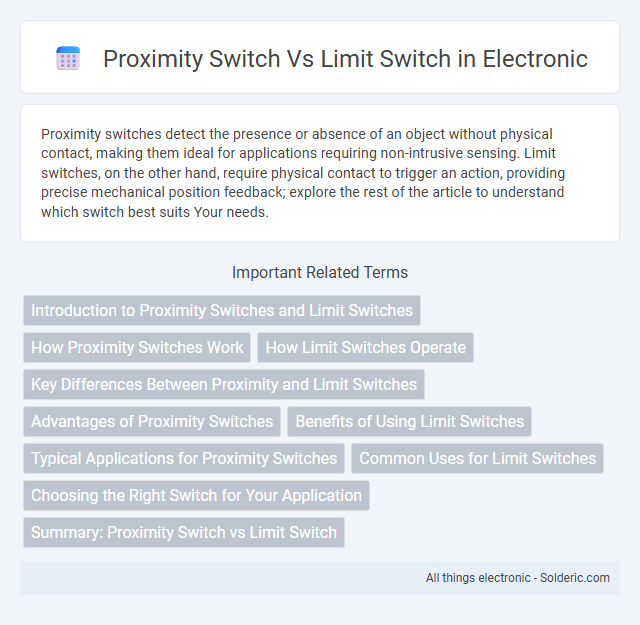Proximity switches detect the presence or absence of an object without physical contact, making them ideal for applications requiring non-intrusive sensing. Limit switches, on the other hand, require physical contact to trigger an action, providing precise mechanical position feedback; explore the rest of the article to understand which switch best suits Your needs.
Comparison Table
| Feature | Proximity Switch | Limit Switch |
|---|---|---|
| Operation Type | Non-contact detection | Contact-based detection |
| Detection Range | Short to medium, depending on type | Physical contact required; minimal range |
| Durability | High, no mechanical wear | Lower, subject to mechanical wear |
| Applications | Metal detection, automation, safety | Position sensing, limit control, safety |
| Response Time | Fast, milliseconds | Fast, but involves mechanical actuation |
| Environmental Tolerance | Good, resistant to dust and moisture | Can be affected by dirt and debris |
| Power Requirement | Requires power for operation | May operate mechanically without power |
| Cost | Generally higher | Generally lower |
Introduction to Proximity Switches and Limit Switches
Proximity switches detect the presence or absence of objects without physical contact, using electromagnetic fields, capacitive, or inductive sensors, making them ideal for automated industrial processes. Limit switches require physical contact to detect object position or movement, providing reliable mechanical feedback for safety and control applications. Understanding the differences between proximity switches and limit switches helps you choose the right sensor for precise positioning or object detection in your system.
How Proximity Switches Work
Proximity switches operate by detecting the presence of objects without physical contact, using electromagnetic fields, inductive, capacitive, or ultrasonic sensors to sense changes in their environment. These sensors emit a signal and measure disruptions caused by nearby materials, triggering the switch when an object enters the detection zone. Unlike limit switches, which require mechanical contact, proximity switches offer faster response times and longer durability in industrial automation and safety applications.
How Limit Switches Operate
Limit switches operate by physically detecting the presence or position of an object through mechanical contact, triggering an electrical circuit when an actuator, such as a lever or plunger, is engaged or released. These switches convert mechanical movement into an electrical signal, which can control machinery, indicate positions, or stop processes. Commonly used in industrial automation, limit switches offer precise control by responding to direct physical interaction with components.
Key Differences Between Proximity and Limit Switches
Proximity switches detect the presence or absence of an object without physical contact, using electromagnetic fields or capacitive sensing, while limit switches require physical contact to trigger mechanical movement or electrical contact changes. Proximity switches offer faster response times and longer lifespans due to non-contact operation, making them ideal for high-speed automation processes, whereas limit switches are more suitable for robust, cost-effective applications requiring precise mechanical positioning. The choice between proximity and limit switches depends on factors such as environmental conditions, target material, required durability, and operational speed.
Advantages of Proximity Switches
Proximity switches offer non-contact detection, which enhances durability by eliminating mechanical wear and tear commonly seen in limit switches. Their ability to operate reliably in harsh environments such as those with dust, moisture, or vibrations provides significant maintenance advantages. Furthermore, proximity switches deliver faster response times and higher precision, making them ideal for automation and precise positioning applications.
Benefits of Using Limit Switches
Limit switches offer precise position control and reliable detection in industrial automation, ensuring machinery safety and operational efficiency. Their mechanical actuation provides dependable feedback even in harsh environments with dust, moisture, or vibration. Using limit switches can extend the lifespan of equipment while reducing downtime and maintenance costs for your automated systems.
Typical Applications for Proximity Switches
Proximity switches are commonly used in industrial automation systems for detecting the presence or absence of objects without physical contact, making them ideal for conveyor belt monitoring and robotic arm positioning. These sensors are also prevalent in automotive manufacturing for precise part detection and metal detection in assembly lines. Their ability to operate in harsh environments with dust, dirt, or moisture enhances reliability in packaging machines and material handling equipment.
Common Uses for Limit Switches
Limit switches are widely used in industrial automation to detect the presence or position of objects, especially in conveyor systems, machinery, and safety interlocks. They provide precise mechanical actuation to control processes such as stopping motors, signaling equipment status, and initiating machine cycles. Common industries utilizing limit switches include manufacturing, packaging, and material handling, where durability and reliable physical contact detection are essential.
Choosing the Right Switch for Your Application
Choosing the right switch for your application depends on factors like sensing distance, target material, and operating environment. Proximity switches offer non-contact detection using inductive, capacitive, or ultrasonic technology, ideal for fast-moving or delicate parts, while limit switches rely on physical contact for precise position control in harsher conditions. Consider your system's space limitations, required durability, and response time to ensure optimal performance with either proximity or limit switches.
Summary: Proximity Switch vs Limit Switch
Proximity switches detect the presence or absence of objects without physical contact, using electromagnetic fields or capacitive sensing, ideal for high-speed or delicate applications. Limit switches require physical contact to trigger an action, providing precise position control and mechanical limit detection in industrial machinery. Understanding your application's need for contactless detection or mechanical actuation helps determine whether a proximity switch or a limit switch is the better choice.
Proximity switch vs limit switch Infographic

 solderic.com
solderic.com